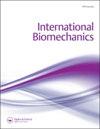On the biomechanical relationship between applied hip, knee and ankle joint moments and the internal knee compressive forces
Q2 Medicine
引用次数: 13
Abstract
ABSTRACT Mechanical devices are common treating methods for knee osteoarthritis. It has the purpose of reducing the internal joint forces and unloading the damaged structure. The reduction is often achieved by alterations in the frontal plan, shifting the contact force from one compartment to the other, leaving the total compressive force unchanged. The aim of this study was to investigate how internal knee joint forces depend on applied external moments during gait. Musculoskeletal models of the gait of 10 healthy subjects were developed in the AnyBody Modelling System and used to simulate applied joint moments about different axes (load cases), each with the magnitude to compensate the net moment about the respective axis by a specified percentage. For each load case, the total, medial and lateral knee compressive force were computed and compared with a baseline case with no external moments applied. Among the investigated moments, hip flexion-extension, knee flexion-extension and ankle plantarflexion-dorsiflexion moment compensations have the most positive impact on the total knee joint compressive force, and combining the 3, each with a 40% compensation of the muscle moments, reduced the first peak by 23.6%, the second by 30.6% and the impulse by 28.6% with respect to no applied moments.髋、膝、踝关节力矩与膝关节内压力的生物力学关系
摘要机械装置是治疗膝骨关节炎的常用方法。其目的是减少内部合力并卸载损坏的结构。减少通常是通过改变正面平面来实现的,将接触力从一个隔间转移到另一个隔间,使总压缩力保持不变。本研究的目的是研究步态中膝关节内部力如何取决于施加的外部力矩。在AnyBody建模系统中开发了10名健康受试者步态的肌肉骨骼模型,并用于模拟绕不同轴(负载情况)施加的关节力矩,每个力矩的大小都能以指定的百分比补偿绕各自轴的净力矩。对于每种载荷情况,计算总的、内侧和外侧的膝盖压缩力,并与没有施加外部力矩的基线情况进行比较。在所研究的力矩中,髋关节屈伸、膝关节屈伸和踝跖屈背屈力矩补偿对总膝关节压缩力的影响最为积极,并且将这三个力矩结合起来,每一个力矩都有40%的肌肉力矩补偿,相对于未施加的力矩,第一个峰值减少了23.6%,第二个峰值降低了30.6%,脉冲减少了28.6%。
本文章由计算机程序翻译,如有差异,请以英文原文为准。
求助全文
约1分钟内获得全文
求助全文
来源期刊

International Biomechanics
Medicine-Rehabilitation
CiteScore
1.90
自引率
0.00%
发文量
2
审稿时长
17 weeks
期刊介绍:
International Biomechanics is a fully Open Access biomechanics journal that aims to foster innovation, debate and collaboration across the full spectrum of biomechanics. We publish original articles, reviews, and short communications in all areas of biomechanics and welcome papers that explore: Bio-fluid mechanics, Continuum Biomechanics, Biotribology, Cellular Biomechanics, Mechanobiology, Mechano-transduction, Tissue Mechanics, Comparative Biomechanics and Functional Anatomy, Allometry, Animal locomotion in biomechanics, Gait analysis in biomechanics, Musculoskeletal and Orthopaedic Biomechanics, Cardiovascular Biomechanics, Plant Biomechanics, Injury Biomechanics, Impact Biomechanics, Sport and Exercise Biomechanics, Kinesiology, Rehabilitation in biomechanics, Quantitative Ergonomics, Human Factors engineering, Occupational Biomechanics, Developmental Biomechanics.
 求助内容:
求助内容: 应助结果提醒方式:
应助结果提醒方式:


